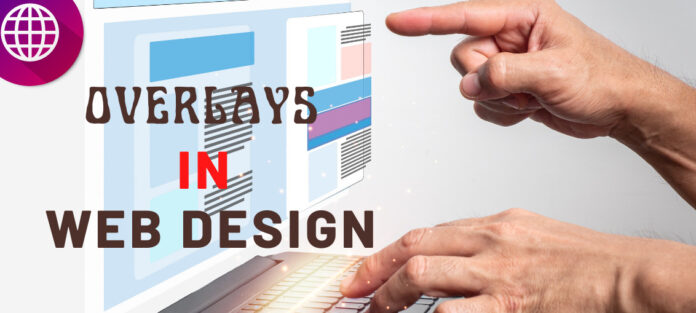Overlays are simple website features that create ‘floating’ islands of content over the main body of a page. They can be programmed to follow a user – being available to a user no matter where they are on a site.
Here are some of the main ways in which web developers and designers have put overlays to use.
Table of Contents
Data Collection Options
In many countries, websites are required to offer users the option to opt out of data collection efforts. Almost all site designers use overlays to offer this option to users. Overlays can ensure that users see their options before they view the main body of the site.

Accessibility
If you are a developer looking to make your site W3C compatible, you can overlay information to improve your website accessibility.
Information is not the only thing that can be overlaid in order to improve accessibility. Text-to-speech, scaling, and contrast controls can be ‘hosted’ on a floating overlay that is always present no matter where on a website a user is.
Overlays are often used as an efficient alternative to more deeply ingrained accessibility measures. They can be used to make a formerly inaccessible website much easier to browse for people with varying abilities.
Chat Bots
Chatbots are a highly effective way to provide excellent customer service features without requiring significant resources. The latest machine learning algorithms power the most advanced modern chatbots.
They can contextually answer customer queries. Chatbots have purportedly passed the Turing Test – convincing scientists that they are indistinguishable from real humans in a test setting.
Overlays are regularly used as display vehicles for chatbots. They enable users to access chat bots as they navigate the entirety of a site. Almost all chatbot overlays can be minimized by users in order to facilitate good UX.
READ ALSO: Importance of CAPTCHA in Web Security
Movement Based Popups
Popup advertisements serve an important marketing function for many companies. Special seasonal deals and products, for instance, can be advertised on a company website via popup.
In recent years, traditional ‘automatic’ popup advertisements have gone out of style. This is largely due to how annoying they can be – potentially damaging the quality of the user experience.
Movement-based popups are now relatively common. These advertisements appear as overlays when site users hover their mouse cursors over small thumbnails. This creates a degree of consent for the popup.
Navigation Buttons
Many websites facilitate ‘endless scroll’ or very long pages. This presents problems when it comes to effective and intuitive navigation. Overlays have been used for the creation of navigation buttons that ‘follow’ users.
Most of these buttons enable users to navigate back to the top of a page – something that would be extremely inconvenient to do if they had to scroll all the way to the top of, say, an endless Tumblr blog.
Overlays Explained: FAQs on Their Use in Web Design
Overlays are a versatile design element used in web design by many experienced developers, such as Ronins, to add functionality and visual interest to a website. Here’s a breakdown of their uses and how they can enhance your website:
What are website overlays?
Overlays are interactive or non-interactive elements that appear on top of a web page’s existing content. They can be full-screen or partial overlays, taking up a specific area of the page.
What are the different types of overlays used in web design?
- Modal windows: These are pop-up windows that appear on top of the current page content, blocking interaction with the background. They’re often used for login forms, signup prompts, or age verification checks.
- Lightboxes: Similar to modal windows, lightboxes focus on a specific piece of content, like an image or video, while dimming the background. They’re commonly used for showcasing product details or portfolios.
- Dropdown menus: These menus appear when you hover over a specific button or element. They’re space-saving and visually appealing for use in navigation menus or as additional options.
- Notifications: These non-intrusive overlays display alerts, messages, or confirmations without blocking the entire page.
- Head-up displays (HUDs): These overlays present essential information directly on the webpage, often used for e-commerce shopping carts or live chat functionalities.
- Navigation bars: Sticky navigation bars that remain visible as you scroll down a page can be implemented as overlays.
What are the benefits of using overlays in web design?
- Enhanced User Experience (UX): Overlays can improve UX by providing focused content or functionality without requiring users to navigate away from the current page.
- Increased Engagement: Well-designed overlays can grab user attention and encourage interaction with specific calls to action or promotions.
- Clear Communication: Overlays can effectively deliver important information or messages without overwhelming users with additional page elements.
- Creative Freedom: Overlays offer design flexibility to showcase visuals, animations, or interactive features that wouldn’t be possible within the main page layout.
Are there any drawbacks to using overlays?
- Accessibility Concerns: Overlays, particularly modal windows, can impede accessibility for users with screen readers or those using keyboard navigation. Ensure proper coding to maintain accessibility.
- User Annoyance: Excessive or poorly designed overlays can disrupt user experience and lead to frustration. Use them strategically and avoid blocking important content.
- Mobile Responsiveness: Overlays need to be optimized for mobile devices to ensure proper display and functionality across all screen sizes.
How can I use overlays effectively in my web design?
- Define a clear purpose: Every overlay should serve a specific purpose and enhance the user experience. Don’t overuse them solely for aesthetic purposes.
- Prioritize mobile responsiveness: Ensure overlays adapt seamlessly to different screen sizes and devices for optimal user experience.
- Maintain accessibility by Using clear visuals and proper coding, and consider alternative options for users who rely on assistive technologies.
- Balance aesthetics and functionality: Overlays should be visually appealing but not distracting. Prioritize user experience and avoid overwhelming users with too much information.
READ ALSO: eCommerce Design Trends
Are there any examples of websites that use overlays effectively?
Many websites leverage overlays strategically. Look for inspiration on websites in your industry and see how they utilize overlays to enhance navigation, showcase products, or convey important messages.
A Final Word…
By understanding the different types of overlays and their functionalities, you can leverage them strategically to create a more engaging and user-friendly web design.
Remember, prioritize user experience, maintain accessibility, and use overlays thoughtfully to achieve your design goals.
For these navigation overlays to be practical, they must be both unobtrusive and easy to find. Design compromise is essential!
INTERESTING POSTS
- Proxy Optimization: 4 Things You Didn’t Know A Proxy Could Do
- Top 5 Cybersecurity Threats That eCommerce Websites Should Watch Out For
- Day Trading Crypto For Beginners Using Trading Bots
- Why Facebook Were Right To Hit F5 And Refresh?
- Top Mobile Design Trends To Know This Year
- Managing Deliveries on the Go: Top Apps for Delivery Professionals
- The Intersection of AI and Privacy: Safeguarding Personal Information in the Age of Intelligent Systems
- Hot Spots On UK Cruises
About the Author:
Marie Beaujolie is a computer network engineer and content writer from Paris. She is passionate about technology and exploring new ways to make people’s lives easier. Marie has been working in the IT industry for many years and has a wealth of knowledge about computer security and best practices. She is a regular contributor for SecureBlitz.com, where she writes about the latest trends and news in the cyber security industry. Marie is committed to helping people stay safe online and encouraging them to take the necessary steps to protect their data.







